You'll find peace and purpose in these calming habitat restoration projects perfect for anxious volunteers. Create a butterfly garden with native plants, clean up quiet streams, nurture native trees, or restore a gentle wildflower meadow. Revitalize peaceful wetlands, build solitary bee houses, or maintain tranquil nature trails. Establish serene bird sanctuaries or install meditative rain gardens. These activities offer a chance to connect with nature while making a positive impact on local ecosystems. Each project provides unique opportunities to reduce anxiety, boost mindfulness, and contribute to environmental conservation. Discover how these hands-on experiences can transform both habitats and your well-being.
Butterfly Garden Planting
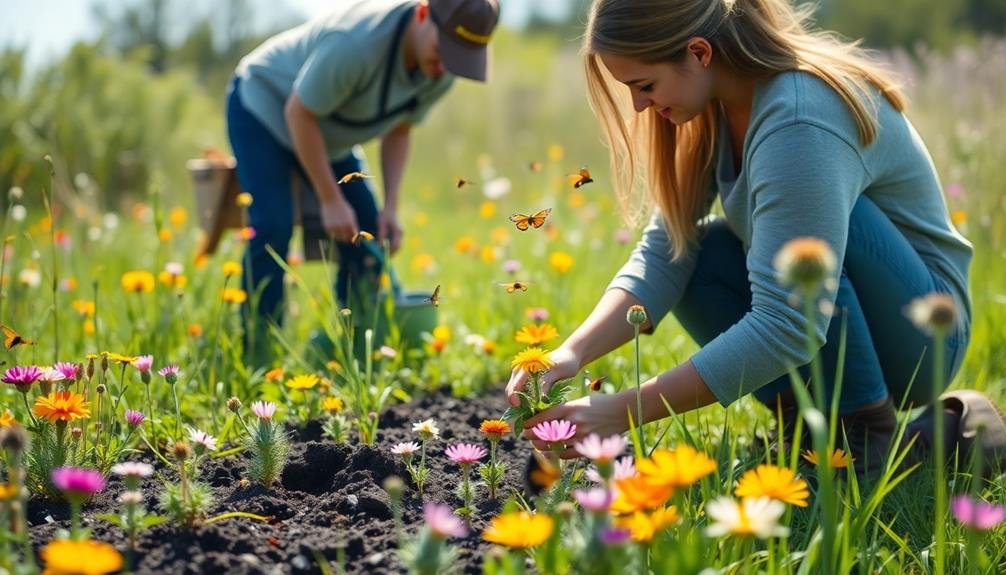
Fluttering with vibrant wings, butterflies aren't only beautiful but also essential pollinators in our ecosystem. Creating a butterfly garden is a calming and rewarding way to contribute to habitat restoration.
You'll need to choose native plants that attract butterflies in your area, such as milkweed, asters, and coneflowers.
Start by selecting a sunny spot in your garden, as butterflies prefer warmth. Prepare the soil by removing weeds and adding organic matter. Plant a variety of nectar-rich flowers in groups, ensuring continuous blooming throughout the season.
Don't forget to include host plants for caterpillars, like parsley and dill.
Create shallow puddles or place flat stones for butterflies to rest and bask in the sun. Avoid using pesticides, as they can harm these delicate creatures. Instead, embrace natural pest control methods to maintain a healthy ecosystem.
As you tend to your butterfly garden, you'll find peace in observing the gentle fluttering of wings and the slow transformation of caterpillars into chrysalises.
Your efforts will provide a safe haven for these important pollinators while offering a tranquil space for relaxation and connection with nature.
Quiet Stream Cleanup
You'll find that quiet stream cleanup offers numerous calming benefits, starting with the gentle water flow that soothes your senses as you work.
As you carefully remove debris, you'll employ peaceful techniques that minimize disturbance to aquatic life and surrounding vegetation.
Your efforts will extend to mindful restoration of the riparian zone, enhancing the stream's ecosystem and creating a tranquil environment for both wildlife and visitors.
Gentle Water Flow Benefits
Babbling brooks and gentle streams are nature's tranquilizers. When you participate in stream restoration projects, you're not just improving the environment; you're also creating a serene space that benefits both wildlife and humans. As you work to restore gentle water flows, you'll notice how the sound of trickling water can soothe your mind and reduce stress.
These gentle water flows play a significant role in maintaining a healthy ecosystem. They provide essential habitats for various aquatic species, from fish to amphibians. The consistent movement of water helps oxygenate the stream, supporting diverse plant and animal life.
You'll see how restored streams create natural filters, removing pollutants and improving water quality. As you help shape the stream's course, you're also enhancing its ability to manage floodwaters and prevent erosion. The gentle flow you're restoring will help stabilize banks and create natural flood plains.
This not only protects nearby areas but also creates a more resilient ecosystem. By participating in these projects, you're contributing to a calming environment that promotes biodiversity, improves water quality, and offers a peaceful retreat for both wildlife and humans.
Peaceful Debris Removal Techniques
The art of peaceful debris removal is essential for maintaining a healthy stream ecosystem. As you approach this task, remember that gentle, mindful actions can greatly impact the environment while preserving the tranquility of the area.
Begin by scanning the stream for visible debris, focusing on man-made items like plastics, glass, and metal. You'll want to prioritize these materials as they're most harmful to wildlife. Use extendable grabbers or nets to reach items without disturbing the water's flow or aquatic life.
When removing larger objects, work slowly and deliberately to minimize disturbance to the streambed.
For organic debris like fallen branches or leaves, assess whether they're causing blockages. If so, carefully remove them, but remember that some natural debris provides valuable habitat for aquatic organisms.
You'll need to strike a balance between clearing obstructions and maintaining beneficial structures.
As you work, be mindful of your movements and noise levels. Speak softly and avoid sudden motions that might startle wildlife.
Mindful Riparian Zone Restoration
After clearing debris, we turn our attention to the riparian zone—the area where land meets water. This critical buffer plays an essential role in maintaining water quality and supporting diverse ecosystems.
You'll focus on restoring native vegetation along the stream banks, which helps prevent erosion and filters pollutants. Start by identifying existing native plants and areas that need improvement. You'll carefully remove invasive species, taking care not to disturb the soil unnecessarily.
Next, you'll plant native trees, shrubs, and grasses suited to your local climate. Choose species that can withstand periodic flooding and provide food and shelter for wildlife.
As you work, maintain a mindful presence. Listen to the gentle flow of water and rustling leaves. Feel the cool earth between your fingers as you plant. Observe how your actions directly contribute to the ecosystem's health.
Create small, strategically placed rock structures to redirect water flow and reduce erosion. These structures also provide habitats for aquatic organisms.
Native Tree Nurturing
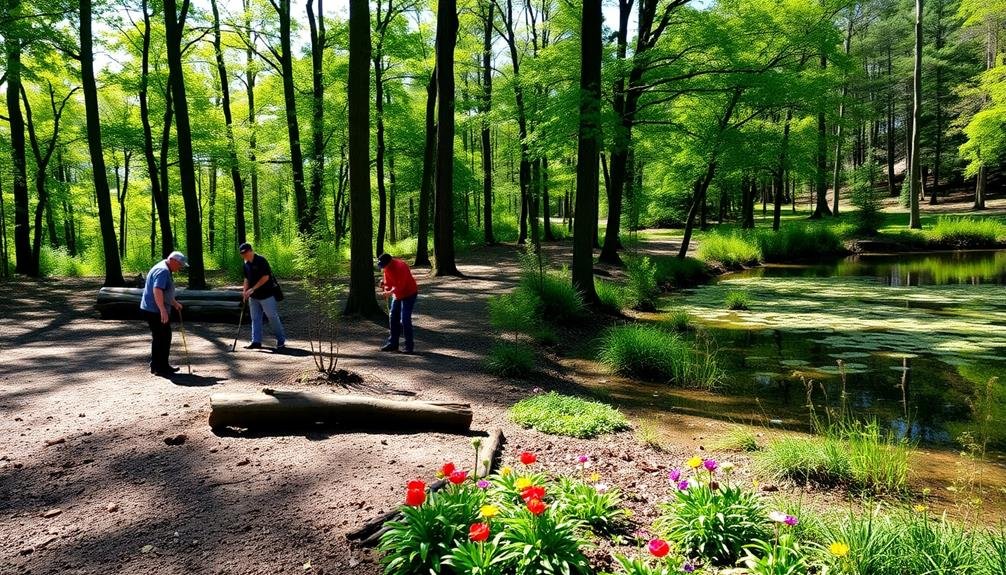
Native tree nurturing stands out from among the most vital aspects of habitat restoration. As you engage in this calming activity, you'll find yourself connecting deeply with nature while making a significant impact on the ecosystem.
Start by selecting native tree species that are well-suited to your local climate and soil conditions. You'll need to carefully plant seedlings or saplings, ensuring they're placed at the correct depth and spacing.
Once planted, your role shifts to caretaker. You'll need to water the young trees regularly, especially during dry spells. Mulching around the base helps retain moisture and suppress weed growth. As you tend to these trees, you'll find the repetitive motions soothing and grounding.
Protection is essential in the early stages. You may need to install guards to prevent damage from wildlife or harsh weather. Pruning is another vital task, removing dead or diseased branches to promote healthy growth.
As you nurture these trees over time, you'll witness their gradual development, which can be incredibly rewarding and therapeutic. Your efforts will contribute to improved air quality, enhanced biodiversity, and a more resilient local ecosystem.
Gentle Wildflower Meadow Restoration
As you commence gentle wildflower meadow restoration, you'll need to carefully select and prepare native seeds suited to your local ecosystem.
You can prepare the soil using low-impact methods that minimize disturbance to existing flora and fauna.
Once ready, you'll plant the seeds and nurture the emerging wildflowers with mindful care, ensuring they establish themselves naturally within the restored habitat.
Seed Selection and Preparation
Selecting the right seeds is essential for a successful gentle wildflower meadow restoration. You'll want to choose native species that are well-suited to your local climate and soil conditions. Research which wildflowers naturally grow in your area and select a diverse mix of annuals and perennials.
Consider including plants that bloom at different times throughout the season to provide continuous color and food for pollinators.
Once you've chosen your seeds, it's time to prepare them for planting. Some seeds may require stratification or scarification to break dormancy. You can mix small seeds with sand to help distribute them evenly when sowing.
For larger seeds, you might need to soak them overnight to soften their outer coatings.
Here are some key points to remember when selecting and preparing seeds:
- Choose native species adapted to your local ecosystem
- Aim for a diverse mix of annuals and perennials
- Consider bloom times to guarantee season-long color
- Research specific germination requirements for each species
- Store seeds in a cool, dry place until planting time
Gentle Soil Preparation Techniques
Soil preparation is an essential step in creating a thriving wildflower meadow. As you begin this phase, focus on gentle techniques that minimize disturbance to the existing ecosystem.
Start by removing any large debris or invasive plants by hand, carefully pulling them out with their roots intact. This method preserves the soil structure and protects beneficial organisms.
Next, you'll want to lightly scarify the soil surface. Use a hand rake or cultivator to create shallow furrows, no deeper than 1/4 inch. This provides ideal seed-to-soil contact without disrupting the soil profile.
If your soil is compacted, consider using a broadfork to aerate it gently. Push the tines into the ground and rock the handle back and forth, creating tiny air pockets without turning the soil over.
For areas with poor soil quality, add a thin layer of compost or well-rotted organic matter. Spread it evenly across the surface, then lightly work it in with a rake. This improves soil structure and nutrient content without overwhelming the native soil.
Mindful Planting and Care
Once you've prepared the soil, it's time to begin the mindful planting process. Approach this task with calm awareness, focusing on each seed or seedling as you carefully place it in the earth. Take deep breaths and appreciate the connection you're forming with nature.
As you plant, consider the future ecosystem you're helping to create. Choose native wildflower species that are well-suited to your local climate and soil conditions. Mix seeds with sand for even distribution, then gently scatter them over the prepared area. Lightly press the seeds into the soil, but don't bury them too deep. Water the area thoroughly, using a gentle spray to avoid displacing seeds.
For ongoing care, practice mindfulness as you:
- Observe plant growth without judgment
- Water mindfully, attuning to the soil's needs
- Remove invasive species with care and intention
- Prune or thin plants thoughtfully when necessary
- Collect seeds mindfully for future plantings
Remember that restoring a wildflower meadow is a gradual process. Be patient and enjoy the journey as your efforts contribute to a thriving ecosystem.
Embrace the changing seasons and the natural cycles of growth and rest, finding peace in your role as a steward of the land.
Peaceful Wetland Revitalization
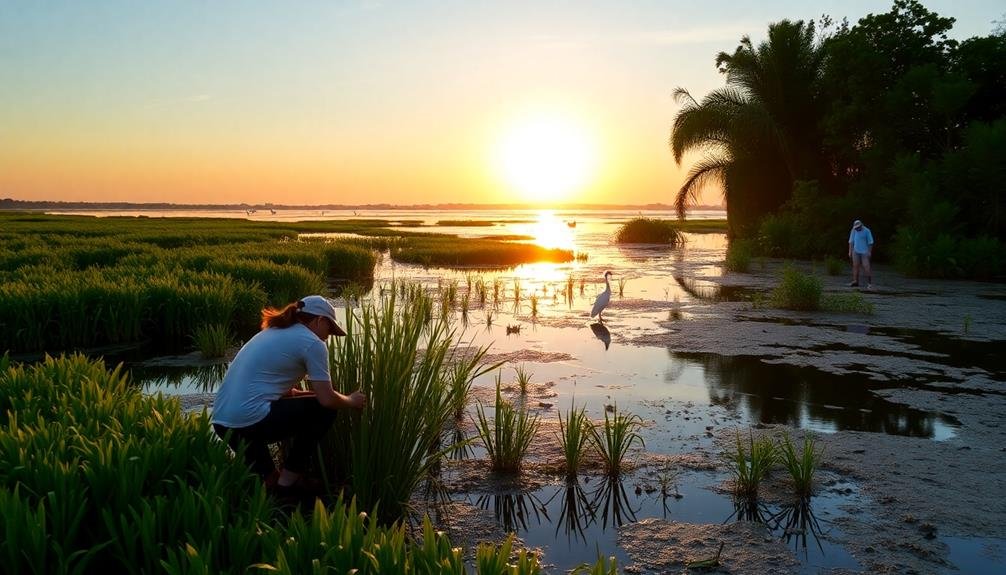
Gentle ripples and the soft rustling of reeds herald the revival of a once-neglected wetland ecosystem. As you wade into the shallow waters, you'll feel the soothing coolness envelop your feet. Your task is to carefully plant native aquatic vegetation, creating a thriving habitat for local wildlife.
Focus on the rhythmic motion of planting as you breathe in the fresh air. You're not just restoring nature; you're finding inner peace through this gentle, purposeful work. Listen for the calls of returning birds and the subtle splash of fish.
Here's a guide to help you identify and plant common wetland species:
| Plant Name | Planting Depth | Sunlight Needs | Wildlife Benefits | Maintenance |
|---|---|---|---|---|
| Cattails | 6-12 inches | Full sun | Bird nesting | Low |
| Water Lilies | 12-18 inches | Full sun | Fish shelter | Medium |
| Pickerelweed | 6-12 inches | Full to part sun | Waterfowl food | Low |
| Arrowhead | 3-6 inches | Full to part sun | Duck food | Low |
| Rushes | 0-3 inches | Full sun | Erosion control | Low |
As you work, you're not just planting; you're weaving a living tapestry that will support countless creatures. Your efforts today will ripple outward, creating a sanctuary for years to come.
Mindful Beach Dune Stabilization
Along the windswept shores, fragile dunes await your careful attention. Beach dune stabilization is an essential step in protecting coastal ecosystems and preventing erosion. As you initiate this mindful project, you'll work with nature to strengthen these delicate barriers.
Your role in dune stabilization involves planting native vegetation, which anchors the sand and promotes natural growth. You'll carefully place plants like sea oats, beach grass, and coastal shrubs in strategic locations. As you work, focus on each movement, feeling the sand between your fingers and the salty breeze on your skin.
Here are key benefits of mindful beach dune stabilization:
- Reduces coastal erosion and protects inland areas
- Provides habitat for native wildlife species
- Improves water quality by filtering runoff
- Enhances natural beauty of the shoreline
- Creates a buffer against storm surge and flooding
As you tend to the dunes, you're not just restoring habitat; you're cultivating inner peace. The rhythmic sound of waves and the gentle rustling of dune grasses create a serene atmosphere.
This project offers a unique opportunity to connect with nature while making a tangible difference in coastal conservation efforts.
Solitary Bee House Building
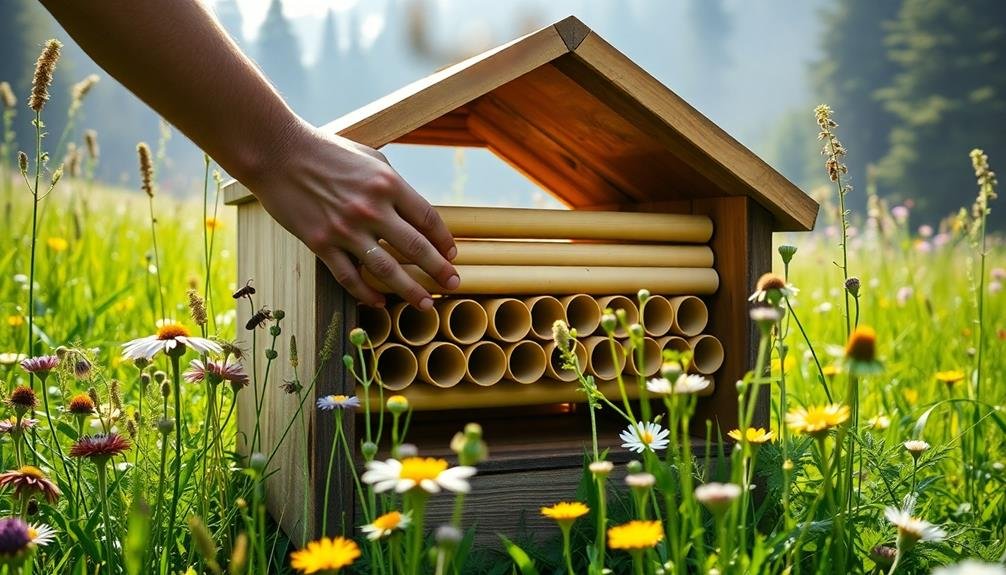
Building a solitary bee house can be a rewarding and calming habitat restoration project.
You'll need to take into account the materials and design, making certain they're suitable for your local bee species.
Once constructed, you'll focus on proper placement and installation, followed by ongoing maintenance and monitoring to guarantee your bee house remains an effective habitat.
Materials and Design
Creating a solitary bee house requires careful consideration of materials and design to guarantee it attracts and supports these important pollinators.
You'll want to use natural, untreated wood for the main structure, as chemicals can harm the bees. Cedar, pine, or bamboo are excellent choices due to their durability and resistance to moisture.
For the nesting tubes, you can use hollow plant stems, paper straws, or drilled wooden blocks. Ascertain the tubes have a variety of diameters between 2-10mm to accommodate different bee species.
The house should have a sloped roof to protect the nesting materials from rain and direct sunlight.
When designing your bee house, consider these key factors:
- Placement: Mount the house 3-6 feet off the ground, facing south or southeast
- Depth: Nesting tubes should be 4-6 inches deep with a closed back
- Protection: Include a wire mesh or chicken wire cover to deter birds and other predators
- Stability: Secure the house firmly to prevent swaying in the wind
- Maintenance: Design for easy cleaning and replacement of nesting materials
Placement and Installation
Once you've designed and built your solitary bee house, proper placement and installation are key to its success. Choose a location that's sheltered from wind and rain, with morning sunlight exposure. Install your bee house 3-6 feet above the ground, facing south or southeast to catch early sun.
Secure the house firmly to prevent swaying, using sturdy brackets or mounting directly to a solid surface. Ascertain it's level and tilted slightly forward to prevent water from entering the nesting tubes. Place your bee house near flowering plants that bloom throughout the season to provide a consistent food source.
| Location | Height | Orientation |
|---|---|---|
| Sheltered | 3-6 feet | South/Southeast |
| Near flowers | Eye-level | Morning sun |
| Away from foot traffic | Accessible for maintenance | Slightly tilted forward |
Consider creating a cluster of bee houses to accommodate different species and increase nesting options. Space them at least 10 feet apart to reduce competition. Remember to clean and maintain your bee houses annually, replacing nesting materials as needed. By carefully placing and installing your solitary bee houses, you'll create a welcoming environment for these important pollinators and contribute to local ecosystem health.
Maintenance and Monitoring
Regular maintenance and monitoring are vital for the long-term success of your solitary bee house. You'll need to check the structure periodically for signs of wear, damage, or pest infestations. Replace any damaged parts promptly to guarantee the bees' safety and comfort.
It's imperative to clean out old nesting materials at the end of each season to prevent the spread of parasites and diseases.
Keep detailed records of bee activity, including species observed, nesting rates, and any unusual occurrences. This data will help you track the effectiveness of your bee house and make necessary adjustments. You should also monitor the surrounding area for changes in plant diversity and abundance, as these factors directly impact the bees' food sources.
- Inspect the bee house monthly during active seasons
- Clean out nesting tubes annually, preferably in late fall or early spring
- Replace damaged or weathered materials as needed
- Record bee activity and species diversity
- Assess nearby flowering plants and adjust plantings if necessary
Tranquil Nature Trail Maintenance
Along tranquil nature trails, maintaining a serene environment is essential for both wildlife and visitors. You'll need to balance preservation with accessibility, ensuring the path remains inviting yet undisturbed. Start by regularly clearing fallen branches and debris, but leave some natural elements to preserve the habitat's authenticity.
Monitor the trail's condition, addressing erosion issues promptly. You can use sustainable materials like wood chips or gravel to maintain the path. Pay attention to invasive species and remove them carefully, replacing them with native plants to support local ecosystems.
Here's a simple maintenance schedule to follow:
| Task | Frequency | Tools Needed |
|---|---|---|
| Clear debris | Weekly | Rake, gloves |
| Check for erosion | Monthly | Shovel, soil |
| Remove invasives | Quarterly | Trowel, plant guide |
| Replant natives | Annually | Native seedlings, spade |
Remember to keep noise to a minimum during maintenance activities. Use hand tools instead of power equipment when possible, and work during off-peak hours to avoid disturbing visitors. By maintaining these tranquil trails thoughtfully, you'll create a calming space for both nature and those seeking solace in it.
Serene Bird Sanctuary Creation
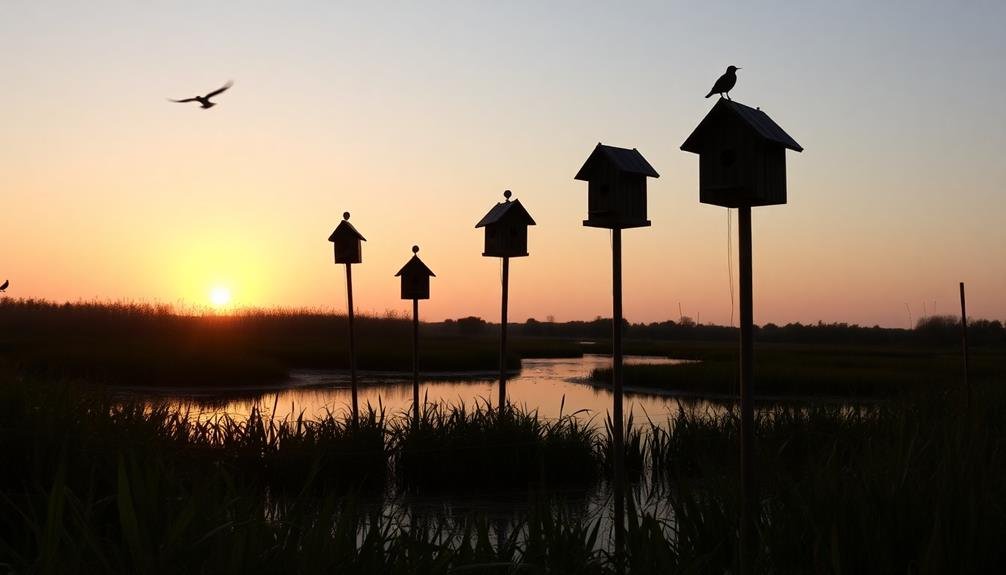
Within the domain of habitat restoration, creating a serene bird sanctuary stands out as a rewarding project.
You'll find that establishing a peaceful haven for our feathered friends not only benefits local wildlife but also provides a tranquil space for visitors to connect with nature.
To create a successful bird sanctuary, you'll need to focus on several key elements:
- Native plants that provide food and shelter
- Water sources like birdbaths or small ponds
- Diverse habitats including trees, shrubs, and open areas
- Nesting boxes and platforms for various bird species
- Minimal human disturbance and predator-free zones
As you work on your sanctuary, you'll learn to identify different bird species and their specific needs.
You'll plant native trees and shrubs, install water features, and create safe nesting areas.
It's important to reflect on the layout carefully, ensuring there are quiet observation areas for visitors without disturbing the birds.
Meditative Rain Garden Installation
A meditative rain garden offers a dual purpose: managing stormwater runoff while creating a peaceful oasis for reflection. You'll find that installing one can be a calming process in itself.
Start by choosing a low-lying area in your yard where water naturally collects. Measure and mark the space, then begin excavating to create a shallow depression.
As you dig, focus on the rhythmic motion of your shovel and the connection to the earth. Select native plants that thrive in both wet and dry conditions, such as sedges, rushes, and flowering perennials. Plant these in layers, starting with the deepest part of the garden and working your way up.
Add a layer of mulch to retain moisture and suppress weeds. Consider incorporating elements like stepping stones or a small bench for meditation. As you work, listen to the sounds of nature around you and breathe deeply.
Maintain your rain garden regularly by weeding and pruning. Over time, you'll notice how it attracts butterflies, birds, and other wildlife. Your meditative rain garden will become a living sanctuary, offering tranquility and environmental benefits for years to come.
Frequently Asked Questions
How Can I Manage My Anxiety While Participating in Habitat Restoration Projects?
You can manage your anxiety by focusing on the task at hand, taking deep breaths, and reminding yourself of the positive impact you're making. Don't hesitate to take breaks, and communicate with team leaders if you're feeling overwhelmed.
Are There Any Age Restrictions for Volunteers in These Calming Projects?
Age restrictions for volunteers vary by project. You'll often find opportunities for all ages, but some tasks may have minimum age requirements. It's best to check with the specific organization or project coordinator for their policies.
What Should I Wear and Bring to These Habitat Restoration Activities?
You'll want to wear sturdy shoes, long pants, and a hat. Bring sunscreen, water, and work gloves. Don't forget snacks and any personal medications. A small backpack is helpful for carrying your supplies.
How Long Do These Calming Restoration Projects Typically Last?
You'll find most restoration projects last between 2-4 hours. They're often scheduled on weekends or evenings to accommodate volunteers. Some longer projects may span a full day, but that's less common. Always check the specific event details.
Can I Bring My Pet to Participate in These Habitat Restoration Efforts?
You'll need to check with the specific project organizers. Many don't allow pets due to safety concerns and potential wildlife disturbance. However, some might permit well-behaved, leashed animals. It's best to inquire beforehand to avoid disappointment.
In Summary
You've discovered a variety of calming habitat restoration projects that can soothe your anxiety while making a positive impact. Whether you're planting flowers, cleaning streams, or building bee houses, these activities offer a peaceful way to connect with nature. Remember, you're not just helping the environment; you're also nurturing your own well-being. So take a deep breath, grab your gardening gloves, and embrace the tranquility of these restorative endeavors. Your mind and the planet will thank you.





Leave a Reply